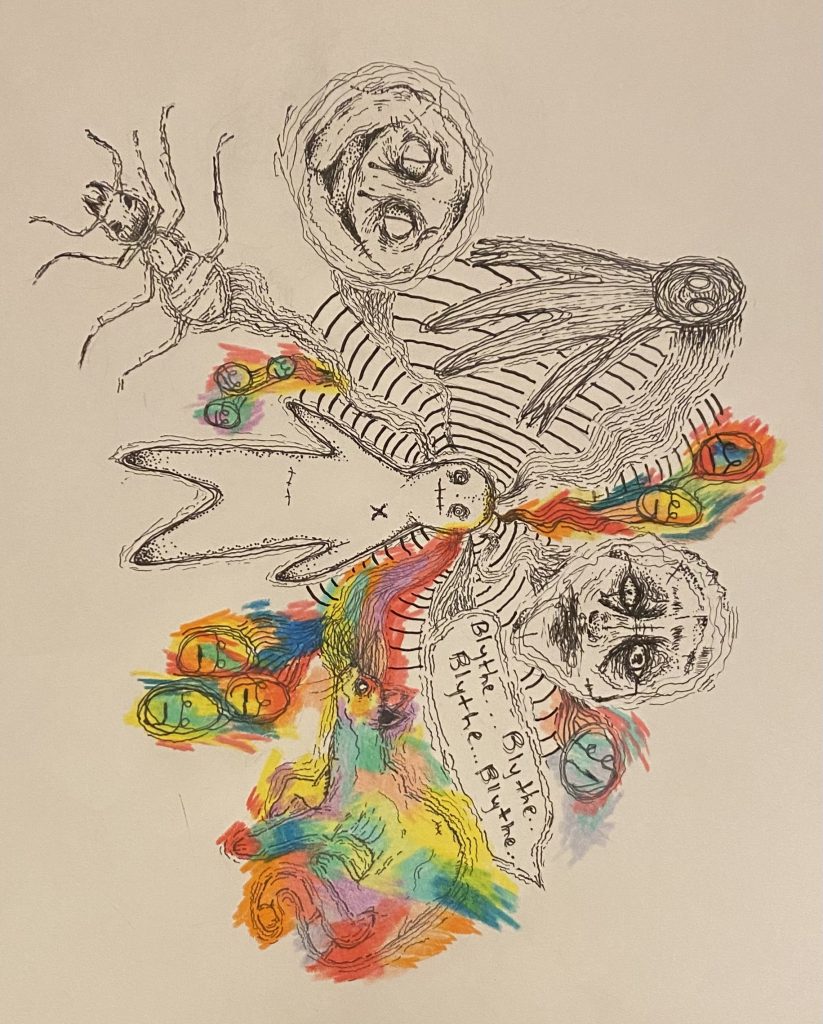In *our previous article, Discovering the Beauty of Life in Psychosis, we introduced the first ever BLIP cohort and shared some of the amazing art created by our peers in the group. We’re excited to share some of the insights and artwork from the second cohort of BLIP, which ran over the course of this summer.
First, a quick recap: what is Beauty of Life in Psychosis (BLIP), anyway?
Beauty of Life in Psychosis (BLIP) is an art and creativity group for young people who self-identify as experiencing psychosis, hearing voices, seeing visions and/or having unique beliefs (VVUB). BLIP is a peer-led group, which means that the facilitators (that’s us – Rory and Anne!) have had similar experiences.
The group was born out of a simple idea: that we deserve safe(r) spaces to socialize, be part of a community, talk about our experiences and express ourselves creatively, all without fear of judgment.
Now, in partnership with Vancouver Coastal Health’s Consumer Initiative Fund, Foundry Virtual BC and Early Psychosis Intervention BC, as well as support from The Paint Spot, we’ve been able to host two successful cohorts – including providing all group members with free art supplies.
The goal of BLIP
The goals of BLIP are to build a sense of belonging, normalize talking about VVUB/psychosis and make space to explore and express the personal meaning of our experiences.
In developing BLIP, it was important for us to recognize that while VVUB/psychosis can be confusing, frightening and difficult, it can also be a “normal” part of life with all the complexity of any other parts of life. VVUB/psychosis can also be funny, annoying, boring, interesting, inconvenient, exciting, frustrating, pleasant, ugly and/or beautiful.
We want to treat VVUB/psychosis as an experience that is part of the unique and valuable perspective we are able to share with the world.
Challenging the definition of “normal”
It only makes sense, that the theme the group chose to focus on was “normalcy”. The group questioned the idea of a single definition of “normal,” pointing out that what’s normal for one person might not be for another person, with an emphasis on the importance of knowing our own minds, bodies and needs best. We discussed who gets to decide what counts as “normal,” and how the pressure to be “normal” can be stigmatizing, isolating or feel like having to wear a mask.
On the other hand, we also talked about how “normal” can be a reassuring reminder of what’s common and expected, helping to ground us in reality. We talked about wanting to be seen as “normal” instead of being treated differently and, on the other hand, the desire to reject being “normal” and reclaim being different, embracing the value of our diverse experiences.
Sharing experiences through art
As a group, we found that some of these experiences are easier to communicate through art rather than words, particularly ones “normal” to us but unfamiliar to others. We also found that even though we all had different definitions of “normal” and different relationships to the concept, one way to feel normal was through being in community with each other: by finding commonality in difference.
We invite you to reflect on how the theme of normalcy comes through in the following works by BLIP artists. We are thrilled to share the artwork created with the first cohort of the BLIP youth group.

Permanent Fever Dream, 2021 Blythe
About the artist: Blythe is a 20 year old individual diagnosed with schizoaffective disorder. She enjoys creating art that depicts her hallucinations and experiences with psychosis, as well as animal portraits. Her favourite mediums to work with are ink, coloured pencil and oil paint.
Artist statement: This drawing in ink and coloured pencil depicts common themes found in my hallucinations. I wanted to capture how, for me, these experiences often labelled “abnormal” can be frightening but also very captivating & interesting. I used bright colours to show which of these visions I perceive as friendly and intriguing.

Self Portrait, 2021 Heart
About the artist: Heart experiences psychosis and uses her art to express her unique beliefs surrounding divinity and fate.
To learn more about future offerings of Beauty of Life in Psychosis (BLIP), or to learn more about groups offered by Foundry’s provincial virtual services, please visit foundrybc.ca/virtual/youth-groups.
To learn more about psychosis read the Questioning Reality section of our website or take the Questioning Reality Self-Check. If you would like to reach out to Foundry for support, reach out to Foundry’s provincial virtual services or visit a Foundry centre near you.
*Note about the authors:
Anne (she/they) is a cat parent and casual peer support worker at Foundry Virtual BC with lived/living experience with voices, visions and unique beliefs, and psychosis. They are also a group facilitator for the BC Hearing Voices Network, Kaleidoscope and a researcher in early psychosis. They enjoy incorporating art and writing into their life as well as keeping active and being outdoors.
Rory (they/them) is a non-binary artist, peer support worker and researcher with lived/living experience of psychosis. They are also a facilitator and administrator for the BC Hearing Voices Network, and their writing on the Hearing Voices Movement recently appeared in Health and Human Rights Journal.